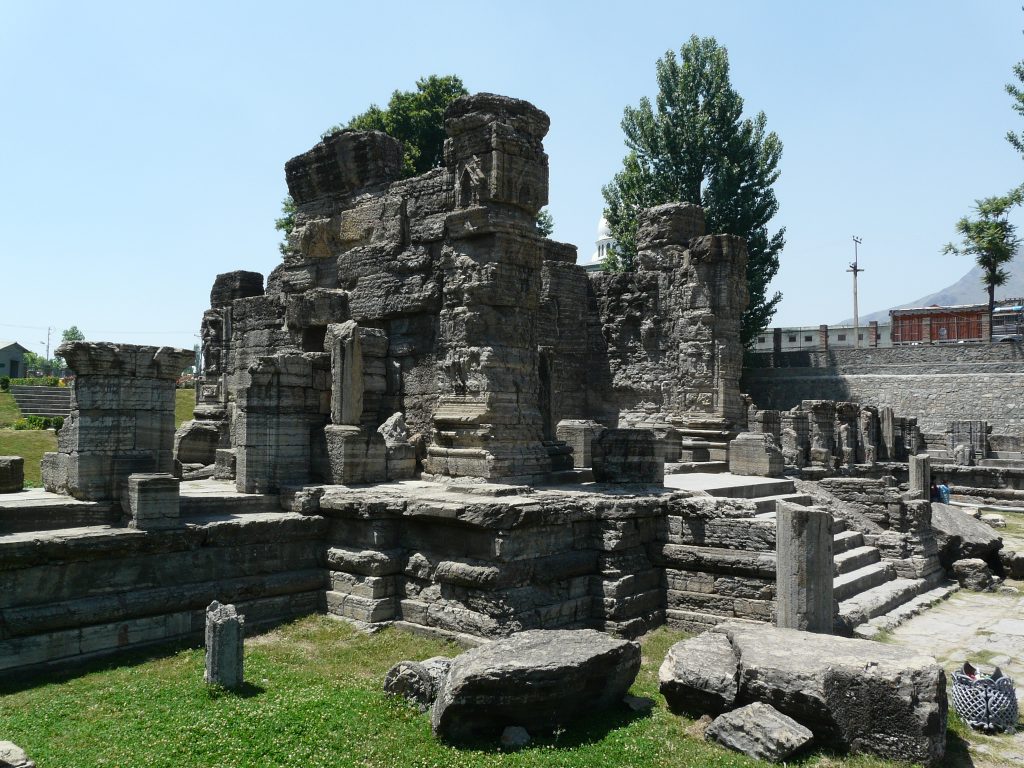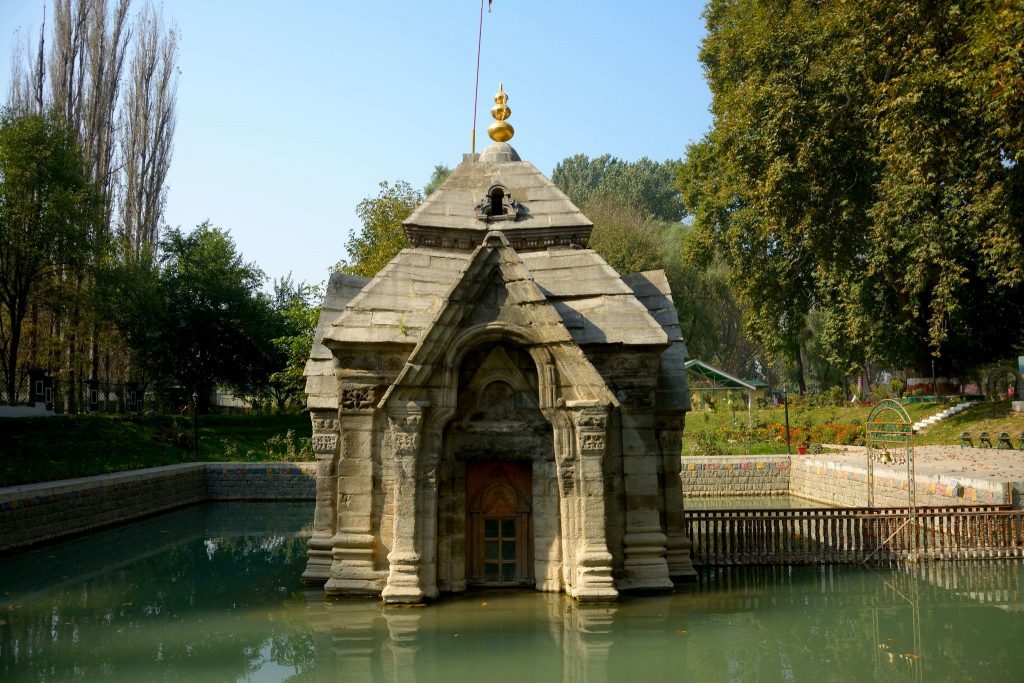Kashmir’s valley is famous all over the world for its mystical and magical beauty. Kashmir has been dubbed “Paradise on Earth” because of its lush green valleys, rolling woods ringed by snow-capped mountains, crisscrossed by rivers and richly decorated with lakes, and abundant profusion of trees, flowers, and fruits. Not only that, temples in Kashmir are also popular all over the country.
Devotees from all over the country visit Kashmir to witness the beauty of these temples . There are also many temples if Kashmir mostly made in the historic times. We will discuss about some of the most popular and ancient temples of Kashmir.
Table of Contents
Here are top 10 most famous temples in Kashmir
Shankaracharya Temple

Shankaracharya Temple is an ancient temple that dates back to the fourth century. Shankaracharya Temple is located on Gopadari Hill in the south-east of Srinagar, 1100 feet above the city’s surface level. Regular buses from Srinagar provide easy access to the temple from the city. Taxis, which are readily available throughout the city, can be used to ensure a comfortable journey.
Raja Gopadatya is said to have built the temple in 371 BC. At the time, the temple was also known as ‘Gopadari,’ after the King’s name. Shankracharya, the great philosopher, is said to have lived here during his visit to Kashmir. The legend vanished centuries ago, and the temple has been known as Shankaracharya Temple ever since.
The Hindu temple is strategically located to provide devotees and tourists with a panoramic view of Srinagar City. The temple, also known as Jyeshteshwara Temple, is reached via a 243-step staircase and is visited by a large number of Hindu devotees during the Amarnath Yatra season. It is one of the most important ancient Hindu temples in Kashmir.
Amarnath Temple

The holy shrine of Amarnath Ji, or Amarnath Temple, is located approximately 29 kilometres from Pahalgam at an elevation of 3,888 metres. Inside the cave is a Shiva Lingam , which Hindus all over the world regard as the most holy symbol.
Devotees flock to it in large numbers from June to August, with the pilgrimage tour known as the Amarnath Yatra beginning in Chandanwari. It is regarded as one of Hinduism’s 18 Maha Shakti Peethas, or holiest shrines. Aside from seeking blessings at the Amarnath Temple, the scenery surrounding it is breathtaking.
You can seek the divine blessings at Amarnath Temple and enjoy the sights surrounding you. Devotees from all over the country visit this places. It is also very known among international travelers and is an important ancient temple in Kashmir.
Martand Sun Temple

Martand Sun Temple, a magnificent shrine dedicated to Surya, is located more than five miles from Anantnag in India’s heavenly state of Jammu and Kashmir. This is a Kashmiri Hindu Temple, and it is considered one of the most elegant structures ever built in India. Even in its ruined state, the temple tells its storey to those who genuinely want to hear it.
The architecture is stunning, and the atmosphere is nostalgic but enticing enough to entice visitors to visit. Visitors must walk across the courtyard to notice the brilliantly fused designs and carvings on the structure, which have withstood the test of time and weather.
The Martand Sun Temple was built between the 7th and 8th centuries. Martand, which means “Sun God” in Sanskrit, is another name for the Sun God in Hinduism. Lalitaditya, the third ruler of the Karkota Dynasty, built the temple complex. The structure is made of limestone, and the entire complex is built on a plateau near Anantnag.
The ruined temple complex has been opened to tourists by the Government of India, and this site is considered to be of National, Historical, and Architectural importance, and thus falls under the jurisdiction of The Archaeological Survey of India. The temple was destroyed by the Shah Miri dynasty in the 15th century, on the orders of the erstwhile Muslim ruler of Kashmir, Sikandar Shah Miri.
Kheer Bhawani

Kheer Bhawani, Ksheer Bhawani, or the Ragnya Devi temple is a Hindu temple located in the village of Tulmul in Ganderbal, 25 kilometres north-east of Srinagar, Jammu and Kashmir, India. It was built over a sacred spring to honour the Hindu goddess Kheer Bhavani.
As is customary with Hindu deities, the goddess has many names, including Ragyna or Rajna, as well as honorific variations such as devi, mata, or bhagavati. The term kheer refers to a milk and rice pudding that is offered to the goddess as a sacrifice.
Kheer Bhawani is also known as the ‘Milk Goddess.’ The worship of Kheer Bhawani is widespread among Kashmir’s Hindus, with the majority of them worshipping her as their protective patron deity Kuladevi.
Devotees of the Goddess Mata Kheer Bhawani fast and gather here on the eighth day of the full moon in the month of May/June, when the Goddess, according to belief, changes the colour of the spring’s waters, which are attributed to various manifestations of the Goddess Mata Kheer Bhawani. The colour changing to shades of black is supposed to indicate impending disaster.
Hari Parbat

Hari Parbat is a hill that overlooks Srinagar, India’s largest city and capital. It is the location of a fort constructed by the Durrani Empire, as well as a Hindu temple, mosques, and gurdwara.
Kashmiri Pandits regard Hari Parbat as sacred. According to mythology, Asura Jalobhava occupied the Hari Parbat area. Local Hindus appealed to Parvati for assistance. She transformed herself into a bird and dropped a rock on Asura’s skull, which grew larger and larger until it crushed the demon.
Hari Parbat is venerated as that pebble, and Parvati is worshipped as Sharika, occupying the middle half of the western slope of the hill where there is a Shakti temple, which is known as Jagadamba Sharika Bhagawati . She is shown with 18 arms and is seated in Shri Chakra.
Sharda Temple

Sharada Peeth is a damaged Hindu temple and old learning centre in Azad Jammu and Kashmir, Pakistan. It was one of the most important temple universities in the Indian subcontinent between the sixth and twelfth centuries CE.
Known for its library in particular, stories tell of scholars travelling considerable distances to access its contents. It was essential in the development and popularization of the Sharada script in North India, earning the script its name and giving Kashmir the title “Sharada Desh,” which translates as “land of Sharada.”
Hindus believe that as one of the Maha Shakti Peethas, it reflects the spiritual place of the goddess Sati’s fallen right hand. Sharada Peeth, together with the Martand Sun Temple and the Amarnath Temple, is one of the three holiest pilgrimage places for Kashmiri Pandits.
It was destroyed 500 year ago by Sikander Butshikhan to establish Islam in Kashmir.
Sharika Devi Temple

The Sharika Devi Temple is located near Srinagar on the western slope of the Hari Parvat. The temple is devoted to Mata Durga/incarnation, Shakti’s Goddess Jagadamba Sharika Bhagwati. The statue within the temple has 18 arms and is revered by Hindus as the patron deity of Srinagar.
This temple is also considered one of the most sacred sites by Kashmiri Pandits, and this day is known as Har Navum. On Sharika Bhagwati’s birthday, the shrine is thronged with worshipers in enormous numbers. They make a special offering to the goddess known as ‘Taher Charvan’.
Shankaragaurishvara Temple

Lord Shiva is worshipped at Shankaragaurishvara Temple, a Hindu temple. This temple is in India’s state of Jammu and Kashmir. The temple is in Baramulla, about 32 kilometres from Srinagar, the state capital of Jammu and Kashmir.
This temple is not currently open for worship. Shankarvarman of Kashmir constructed the temple between 883 and 902 AD. The temple is currently in a dilapidated state. As a result, worship is no longer held.
This temple was constructed in the same manner as the Shankaracharya temple. This temple’s name appears in the list of major tourist destinations in the state of Jammu and Kashmir, and it is one of more than 15 important temples for promoting tourism in the state of Jammu and Kashmir.
Pattan is on the National Highway. Pattan is a half-hour drive from Srinagar. Access to the temple is possible via buses and private taxis.
Avantiswami Temple

Awantipora, a small but historically significant town in Jammu Kashmir’s Anantnag district, is located on the banks of the Jhelum River, 28 kilometres from Srinagar. During the years 855–883 AD, King Avantivarman of the Utpala dynasty founded the town.
As a result, the location was given the name Awantipora. He built two magnificent temples in Avantipura, one for Lord Vishnu called Avantiswami and the other for Lord Shiva called Avantisvara.
Avantiswami temple was built prior to his accession to the throne, and Avantisavara temple was built after he achieved sovereignty. During the mediaeval period, the temple was subjected to invasion and destruction. It was eventually reduced to ruins. This temple was destroyed in 14th century by Sultan Shikandar.
Pandrethan temple

Pandrethan is an ancient stone temple dedicated to Lord Shiva that is located north of the Jhelum River in a square-shaped tank. It is about four miles from the city of Srinagar. Meru, minister to King Partha, who ruled Kashmir from 921 to 931 AD, built the temple, also known as Meru Vardhana Swami.
The temple’s roof was carved out of a single piece of rock and is known for its intricate designs and illustrations. The temple’s domed roof and arches are excellent examples of classic Kashmiri architecture.
And this concludes our articles on Temples in Kashmir. Please make sure to like and share this article. If you think we missed any important temples in Kashmir than make sure to write to us in the comment section down below.
You may also like Kashmiri Shiv Bhajan.
